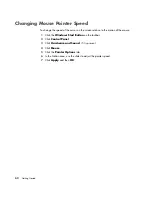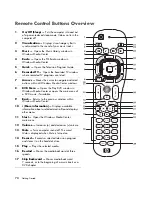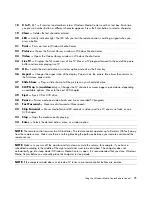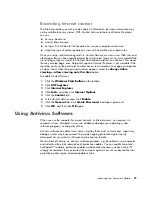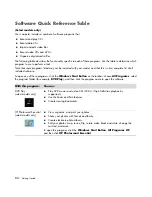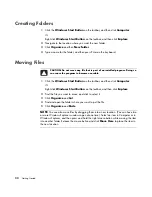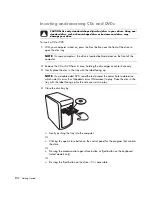
Introducing Your Computer Software
79
About the Internet
This section describes connecting to and using the Internet, including how to use a Web
browser and electronic mail (e-mail).
Use the Internet to search for information or services on the Web, or to retrieve, read, or
send e-mail messages.
The
Internet
is a group of computers that communicate with each other through telephone
lines, digital services, or cable lines. Each Internet computer is independent, and its
operators choose which files to make available to users of the Internet. To connect your
computer to the Internet and use the information and services available there, you need an
Internet Service Provider (ISP).
ISPs
are businesses that give you access to the Internet, and most of them provide e-mail
service. ISPs usually charge a monthly fee for their services. When your computer connects
to the Internet, it is actually communicating with the Internet computer belonging to the ISP.
The ISP verifies your account and then provides you access to the Internet. You use a Web
browser program to search for and display Web site information. Some ISPs allow you to
choose a browser program, while others provide their own browser.
Your connection to an ISP may be through a traditional telephone dial-up modem, a local
area network (LAN), cable modem, digital subscriber line (DSL), or asymmetric digital
subscriber line (ADSL). (DSL, ADSL, and cable ISPs are not available in all countries/
regions.)
The
World Wide Web
(WWW), also called the Web, is a public part of the Internet used
by individuals, companies, governments, and organizations. These individuals and groups
have created millions of Web sites in support of their activities. A Web site consists of one
or more Web pages. A
Web page
is a file or group of files that a user can access by
entering the file location, or Uniform Resource Locator (URL).
The
URL
identifies a Web site location, typically in the form
http:
//
www.name
.
extension
(for example,
http://www.hp.com
). The URL may include the path to a specific file
within that site. Each period, or dot, in the URL separates elements within the address. For
example, you will see the URL extension
.com
used by companies. When you enter the URL
into your browser address box and press the Enter key on your keyboard, the browser
contacts that location and displays the Web page for you.
Imagine you are reading a newspaper. On page 1, you may read something like
For
more details, see page 3, column 2
. You turn the page for more information. A
hyperlink
on a Web page works the same way, except that you move to the new page by clicking
the hyperlink. The way that a hyperlink links files together is what gives the Web its name,
because the Web weaves together and connects ideas from all over the world.
Your
e-mail address
identifies the electronic post office box where people can send you
electronic mail. E-mail addresses have the form
name@domain
.
extension
. The domain is
usually the name of the ISP or organization. The extension usually identifies the type of
organization. For example, if your name is Jane Jones, and XYZ is your ISP, your e-mail
address might be [email protected], with the extension
.com
indicating that XYZ is a
company. For information on using e-mail, see “Sending and Receiving E-Mail.”
Summary of Contents for A1710n - Pavilion - 1 GB RAM
Page 1: ...Getting Started ...
Page 10: ...x Getting Started ...
Page 26: ...16 Getting Started ...
Page 66: ...56 Getting Started ...
Page 74: ...64 Getting Started ...
Page 84: ...74 Getting Started ...
Page 102: ...92 Getting Started ...
Page 108: ...98 Getting Started ...
Page 134: ...124 Getting Started ...
Page 156: ...146 Getting Started ...
Page 188: ...178 Getting Started ...
Page 194: ...Part Number 5991 6837 ...




